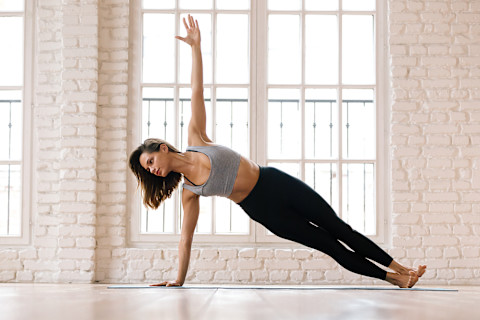3 Easy Exercises Women Can Try After Giving Birth (If Cleared By A Doctor)

Imagine it—you just went through the miracle of pregnancy and childbirth. You are elated, excited, exhausted. Your body does not quite feel the same as it did before. Once the initial emotions of bringing a new person into the world have worn off, you are ready to get back to all the things you enjoyed before the baby was born. You are ready to exercise, but where do you start? Is it okay to just pick up where you left off? Should you start something new? How much is too much?
The answers vary for every woman. Some factors to consider are:
- Your fitness level prior to pregnancy
- Activity level during pregnancy
- Type of delivery
- Complications of pregnancy and/or delivery
- Amount of sleep you are getting
- Are you breastfeeding?
- How do you feel?
Every person is different, and will move at a different pace. Respect your body, and do what feels good. I recommend starting with a foundation—a stable base where you can build and grow. While you should wait to return to cardiovascular exercise and strength training until you have received clearance from your OB/GYN, there are some exercises you can start in the initial days and weeks after childbirth that will help you build your foundation. Foundation exercises should include general mobility, breathing, pelvic floor muscle activation and relaxation, and exercises to help retrain the gluteal muscles.
Here are some exercises you can try—listed in order of easiest to most advanced.
Diaphragmatic Breathing & Pelvic Floor Muscle Activation/Relaxation
Pelvic floor dysfunction is common after childbirth, and may lead to things such as urinary or fecal incontinence, pelvic organ prolapse or pelvic pain. The PFM become susceptible to injury due to stretching throughout pregnancy and pushing during labor. Taking time to rehabilitate these muscles in the early postpartum period can improve or prevent these symptoms. The diaphragm’s primary role is to control breathing. It also makes up part of the deep core system (along with the low back muscles, abdominals and PFM). Postural changes during pregnancy can affect diaphragm function. Due to these connections, addressing breathing early in the postpartum period may improve not only overall endurance but also the function of the abdominals and PFM.
This is a foundational exercise—for which I've provided instructions below.

- Start by lying on your back with your knees bent in a comfortable position. You can also try this lying on your side or on your hands and knees.
- Take a deep breath in. Feel your ribs expand upward and outward, and your chest and belly rise.
- As you exhale, your ribs should move down and inwards, and the chest and belly should fall. (All 3 areas—chest, ribs, belly—should be involved. When these muscles are coordinated, that indicates good diaphragm function.)
- Once you feel comfortable with breathing, turn your focus to the PFM.
- As you inhale, the diaphragm contracts and flattens and the PFM relax some, and lengthen.
- When you exhale, the diaphragm relaxes, becoming more dome-like, and the PFM begin to contract. (A good image for what the PFM should be doing is imagine you are using your vagina to squeeze and lift a kidney bean.)
- With each exhale, squeeze and lift the kidney bean. Work up to holding it for 10 seconds.
- Continue to breathe.
- Practice often, with a goal of 10 repetitions, twice a day
All-Fours Knee Lift
Working in the quadruped position (all-fours) is a good way to address core control and coordinate arm and leg movement. I consider this to be a basic movement—a step up from foundational and a step below advanced. By lifting one leg, this exercise targets the abdominals, deep low back muscles and glutes. By alternating sides, it addresses weight shifting necessary for high impact activities like running.

- Begin on your hands and knees with your hands under your shoulders and your knees under your hips with a neutral spine (not arched or sway).
- Take one breath to prepare, activating the PFM as you exhale.
- On the next exhale, lift one knee off of the floor, enough that you could slide a piece of paper under it.
- Hold 5 seconds and return to start.
- Continue, alternating sides.
- For a challenge, try straightening one leg behind you without arching or twisting the trunk.
- Work up to three sets of 5 repetitions on each leg, once a day.
Side Plank
The most advanced of the three, this exercise works the deep core muscles, the abdominals and the lateral hip muscles.

- Begin lying on your side with your trunk propped on your forearm, hips stacked and knees bent.
- Take one breath to prepare, and activate the PFM as you exhale.
- On the next breath, exhale.
- Imagine you are pulling the inner part of your support arm toward your torso, lift your ribs and then your hips. You will be in a side plank position.
- Hold for up to 10 seconds.
- For challenge, begin with your legs straight.
- Work up to 10 repetitions, once a day.
It's worth reiterating that every woman is different and should take recovery at their own pace. Once you've been cleared by your doctor, these exercises can help you regain your body's strength and ease you back into your exercise routine!

